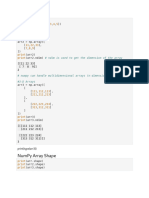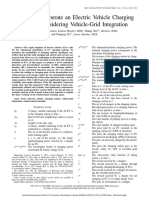0% found this document useful (0 votes)
13 views8 pagesDAY 1-Numpy - 18.12.24-Data Science
This document provides a comprehensive overview of using the Numpy library in Python, covering array creation, manipulation, and mathematical operations. It includes examples of creating arrays, performing arithmetic operations, and utilizing various Numpy functions for array analysis. The document also discusses array properties such as shape, size, and data types, along with methods for sorting, concatenating, and splitting arrays.
Uploaded by
abinaya.selva2020Copyright
© © All Rights Reserved
We take content rights seriously. If you suspect this is your content, claim it here.
Available Formats
Download as TXT, PDF, TXT or read online on Scribd
0% found this document useful (0 votes)
13 views8 pagesDAY 1-Numpy - 18.12.24-Data Science
This document provides a comprehensive overview of using the Numpy library in Python, covering array creation, manipulation, and mathematical operations. It includes examples of creating arrays, performing arithmetic operations, and utilizing various Numpy functions for array analysis. The document also discusses array properties such as shape, size, and data types, along with methods for sorting, concatenating, and splitting arrays.
Uploaded by
abinaya.selva2020Copyright
© © All Rights Reserved
We take content rights seriously. If you suspect this is your content, claim it here.
Available Formats
Download as TXT, PDF, TXT or read online on Scribd
/ 8













































































